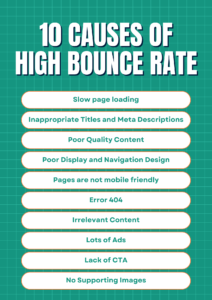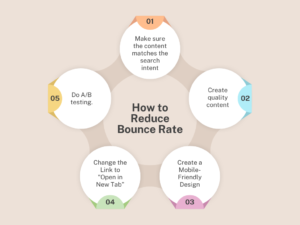
If you manage a website, then one of the main problems you need to avoid is a high bounce rate. This is important to pay attention to, especially if the website is intended as a business website.
Why is that?
A high bounce rate is an indication that the quality of the website is inadequate. It could be that your website is not loading information fast enough when visitors access it.
In addition, visitors may be annoyed by the design or ads that are too busy. In this article, we discuss the causes of a high bounce rate, complete with how to reduce it.
What is bounce rate?
There are many factors that cause a high bounce rate. If you don’t address it immediately, generating conversions from your website will be a pipe dream.
The bounce rate is a percentage that explains how high or low visits without interaction are on a website.
More specifically, this percentage indicates the number of visitors who open only one page and immediately leave the website without any further action.
The actions in question are like clicking the menu button or internal links on the page.
To calculate the bounce rate, you can use the division of single-page visits contained in all types of traffic.
If the percentage is getting higher, you should be alert. The website is likely of poor quality, so you need to evaluate its strategy again. Especially the website’s SEO strategy.
The ideal bounce rate should be at a percentage of less than or equal to 40%.
If the percentage is at 60% or higher, you should make improvements to the website content.
Causes of High Bounce Rate
After understanding what bounce rate is, learn the various factors that cause a website to be at risk of having a high bounce rate below:

1. Slow page loading
The first factor that generally occurs is because the website page is slow to load its content.
One of Google’s newest metrics as the largest search engine is ‘Interaction to Next Paint’.
This metric is in Core Web Vitals. The focus of the metric is website speed. That is why slow-loading website pages will trigger a higher bounce rate.
Website speed has indeed been part of Google’s ranking algorithm for a long time. This is because one of Google’s main goals is to provide a positive experience for its users.
If a website is slow to load its pages, visitors automatically feel an unpleasant experience.
This is one of the reasons why Google now provides AI overviews and featured snippets in search results.
2. Inappropriate Titles and Meta Descriptions
The next cause is the inconsistency of the title and meta description with the content. You must ensure that the title and meta description describe the content briefly.
If they are not appropriate, visitors will leave the website quickly because they think they are accessing the wrong page.
They will return to the search results page to find the website that best answers and matches the query.
That’s why you should maximize your title and meta description to make it attractive to Google users.
Think of both elements as ads. The phrases or sentences should also reflect a summary of the page’s content relevantly.
Don’t try to create clickbait titles or meta descriptions! Create titles and descriptions as they should be to minimize the bounce rate.
3. Poor Quality Content
A reason that is often overlooked but is prone to increasing the bounce rate is inadequate content quality.
Conduct an honest content assessment by involving the appropriate parties, such as copywriters or marketers.
However, your content may already be of high quality. It’s just that you haven’t optimized it for visitors who will read the content online.
You can also work with SEO Article Writing Services from IndonesianWriter. Reliable writers are the solution so that your interesting ideas can be transformed into quality content.
The website SEO strategy becomes more effective so that it can minimize the bounce rate and generate conversions.
4. Poor Display and Navigation Design
If your website design and navigation are poor, visitors will be confused about digesting the information in it.
This triggers an increase in the bounce rate on the website because visitors will leave the website in a flash.
Especially if the design is less intuitive and full of text without clear visual navigation elements. However, design and navigation that are too full are also less than ideal.
Therefore, make sure the interface on the website is designed intuitively. Avoid placing supporting visual elements such as email subscription buttons in every part of the website.
This risks disturbing visitors who are trying to read your content information.
You can add elements such as menus or search boxes to make it easier for visitors to navigate the website.
Also, make sure that these elements can be seen clearly by visitors so that they are not prone to bouncing.
5. Pages are not mobile friendly
In 2017, Google released an announcement regarding the transition to mobile device indexing. Website owners are also busy making website pages more mobile-friendly.
If you haven’t done this practice until now, then it could be what triggers the bounce rate.
Website optimization for mobile devices is very important so that the website looks good when visitors open it with a smartphone.
Especially considering that 60% of website traffic comes from mobile device users.
Websites that are not mobile friendly usually have errors such as text that is too small to read, content that exceeds the screen width, and links that are too close together.
6. Error 404
Error 404 or Error 404 is a factor that makes visitors leave the website after entering for a few seconds.
In fact, visitors are likely not to return to your website because they feel the website is broken.
To make sure, you can visit the website yourself through the most popular browsers and configurations.
Such as Chrome on Android and Safari on iPhone. Support by checking the website on the Google Search Console platform and selecting the ‘Pages’ menu.
Make sure you seek professional help to resolve Error 404 on your website. Don’t let it be so that your website is not removed from the search results page by Google.
7. Irrelevant Content
This cause is related to the third cause of poor quality content. Not only quality, bad content is also prone to triggering an increase in bounce rate.
However, irrelevant content also makes website visitors leave the site very quickly.
Usually, the characteristic of irrelevant content is that it does not contain credible internal links.
That’s why you should increase relevance by linking internal links to the content.
The main thing is also to make sure the website displays relevant content that matches the visitor’s search.
8. Lots of Ads
The cause of a high bounce rate on a website also occurs due to too many ads. Especially when the ads pop up or the ads block the main content of the content.
Visitors who see it will automatically feel disturbed and lazy to explore the website further.
So, they immediately leave the website and end up creating a bounce rate. If you want to place ads on the website, make sure their position does not cover the main content.
9. Lack of CTA
Call-to-Action, or CTA, is a content element that you must have. However, make sure the CTA is clear, sufficient, and attractive.
If the CTA is lacking and unclear, then website visitors will end up contributing to the website’s bounce rate.
Words or phrases in the CTA should explain the next action that visitors need to take. So, visitors can stay longer on the website because they take action.
10. No Supporting Images
Supporting images serve to increase the appeal of the website for visitors.
If you don’t add images, videos, and infographics as supporting visual elements, then the website tends to be less attractive.
This makes visitors lose interest even before reading the content on the website. For those who read it, visitors will easily get bored because the content is only text.
So, enrich website content with supporting images to minimize the bounce rate.
How to Reduce Bounce Rate
You can reduce some of the causes of high bounce rates on the website by doing the following five solutions.

1. Make sure the content matches the search intent
What would you do when you visit a website that doesn’t match your search intent?
Go back to the search page to find another website that does, right?
That’s what visitors are most likely to do. Search intent is a determining factor in the bounce rate on a website.
So, ensuring that the content matches the search intent will reduce the bounce rate.
2. Create quality content
Getting visitors to read the content on the website until the end requires special tips and tricks.
One way is to organize the content neatly so that visitors can read and scan it quickly.
Create content with short paragraphs so that visitors can read and understand the core content quickly.
In addition, also use heading tags (H1, H2, H3) in the content so that visitors can understand important points immediately.
Also add visuals such as illustrations, photos, videos, and infographics so that visitors feel at home reading your content.
Make sure the visuals are relevant and support the content so that the quality increases and the bounce rate decreases.
3. Create a Mobile-Friendly Design
Next, create a mobile-friendly website design. This is because mobile devices are the most used by internet users in Indonesia.
In fact, 94% of internet users in Indonesia access the internet with mobile devices.
4. Change the Link to “Open in New Tab”
In the website content, you need to include at least three to four links internally and externally.
Apply the ‘open in new tab’ setting when you include the link before spreading it.
More clearly, ‘open in new tab’ will make it easier for visitors because they don’t need to press the back button repeatedly when they want to go to the first page.
If you don’t change it, then not only will the bounce rate be high. However, the exit rate is also at risk of increasing.
5. Do A/B testing.
If you are not sure what changes are needed to reduce the bounce rate, then do A/B testing.
Experimenting with different updates can be tried to see how the audience responds.
For example, try changing the title, heading, image, content, design, to the layout that changes. These various elements will show varying results.
At the end of the testing period, you can analyze and evaluate the elements that reduce the bounce rate.
Conclusion
Now, you know what causes a high bounce rate or an increasing bounce rate on a website. You can try various methods above to reduce the bounce rate until you find the most ideal one for your website.
One way to reduce the bounce rate is to create quality content. You can collaborate with IndonesianWriter through SEO Article Writing Services.
Our team of writers is experienced and professional in producing quality content. You just sit back, leave the SEO content for your website to us!
IndonesianWriter upholds originality, so your content is guaranteed to be free of plagiarism. Contact us now to reduce your website’s bounce rate!





